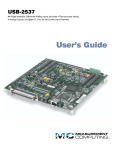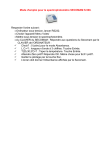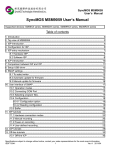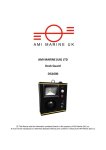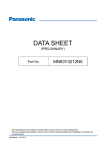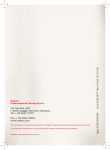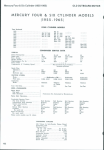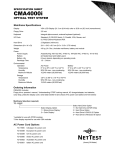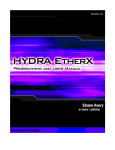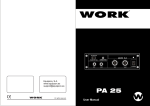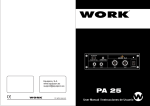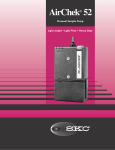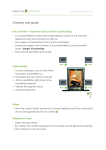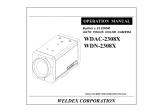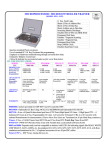Download Report
Transcript
Abstract There is so many blind persons that use a blind stick to help their dally walking or life. But the blind stick will be hit some person when the blind stick waggling. So there is need to develop new walking stick that the stick can be detected the obstacle stealthy. So the bat are the very best object to learn at to stealthy detected the obstacle. From observe the bat, we have a conclusion that use a ultrasound for the detected the obstacle is a good way to do and the new walking stick is use ultrasound theory of the bat perform by the microproccer and the electronic component. This walking stick can be help the blind persons or the person hit by the old waggling blind stick. 3 3 Aims This Electronic Walking Stick for the Blind is use to help the blind person to detect obstacle and depressions in front of him. After detect an object in front of the blind person the Electronic Walking Stick will be sound a the tone of warning signal and warning signal will change gradually when the blind person get closer to the obstacle. Also if too close to the object it will generate a vibration signal with the vibrator. 4 4 Scope In our project, we will focus on the ultrasound propagation technique, sound speed. And follow are the basic theory the ultrasound propagation technique sound speed in the free air Pulse-echo technique. This technique is a means of underwater Echolocation developed by the military for locating submarines. Brief pulses of ultrasound, ranging from 21kHz to 50 kHz, are emitted in narrow, intense beams. The pulses hit to hard surface it makes the echoes of these pulses, returning at different time intervals depending on the Speed of Sound in the medium. Form the timing from travel time between measurements to surface can be converted the distance between each other. Here are the times schedule of the pulse-echo technique detect method. 5 5.0V Reflect pulse 0V Emit detect pulse (Ultrasound) -5.0V 0s 2ms V(R2:2) V(R1:2) 4ms 6ms Emit detect pulse (Ultrasound) 8ms 10ms Time 5 12ms 14ms 16ms 18ms 20ms The speed of the ultrasound in the air In 1816, the mathematician Laplace proposed that the speed of a longitudinal wave in a gas is given by Where p is the pressure of the gas, p the density , and γ is a dimensionless constant(the ratio of the specific heats of the gas: this is covered in the unit Thermal properties) In the Atmospheric pressure, γ=1.4, P = 0.76x13600x9.8 Pa, p =1.24, so that v is 6 ν = 332 ms-1, it means that the ultrasonic will traffic in the air is 332m per second. 7 6 Specification Supply voltage: 12v(supply by high voltage battery VA23GA) Transmit & receiver frequency: 40kHz Detect method: pulse –echo technique Sampling rate: 1 time/second Detect range: 10 feet Accuracy: +/- 1 feet 8 Detect angle: 45° 7 Design B lo c k / s y s te m le v e l d ia g ra m fo r h a rd w a re U ltr a s o u n d p u ls e g e n e r a te u n it P ro d u c e b y 8 9 c 5 1 P iz e o e le c tr ic T r a n s d u c e r ( tr a n s fe r p u ls e S ig n a l to u ltra s o u n d ) T r a n s m is s io n p a r t T h e s ig n a l d e t e c t o r & d is t a n c e c o u n te r M e d iu m (a ir ) R e fe c t s ig n a l W hen h it th e o b je c t T h e w a r n in g s o u n d g e n e ra te r T h e v ib ra to r fo r th e v ib ra tio n w a r n in g s ig n a l C P U p a rt 9 8 S ig n a l a m p lif e r T im e b ase R e c e iv e r p a rt -Circuit diagram The hardware part will be break down to three parts to discuss The first part is transmission part, the 40khz ultrasound that generate by the microproccer, that though the 4069 and the sin wave that will transmit the ultrasonic though by the transducer, 4069 that is a hex inverter buffer to use to buffering and shaping the pulse more like than the sin wave. The circuit will be show as follow 10 9 As follow is the receiver part circuit: An6551 The first stage of the amplifier gain 10,and the second stage amplifier gain 13 times total gain is gain 10 *13 = 130, about 40db gain and output to the microproccer. The first stage of the amplifier is the high pass filter the 100p cap. Is use to filtering the noise under the 40khz signal, the resistor of the cap. is xc = 1/ 2πf* c For example at 37khz or below xc = 1/2π37k * 100p = 43k or bigger, the resistor is good enough to limit the current to flow to amplifier. The second stage amplifier will call by VCVS- voltage controlled voltage source amplifier. This is one of the types of the butterworth filter. And RC factor can defined by follow equation c = 1/√2πfo R, as r = 560k,freq(fo) = 40khz, c = 11/√2π*40khz *560k = 100p. As upper result, second stage is a bandpass filter that selected 40khz signal. 11 1 0 Here are third parts of the hardware, the CPU part: 89c2051 The CPU P1.7 generate a 3ms width 40khz pulse signal to the transmission part, after that the INT0 wait to receive a signal from the receiver part. Whatever the receiver part have a signal or not, that the CPU will generate a sound about every signal second to indicate the CPU is running properly. If a reflect signal was pick up at the receiver part, the burst sound will be generate. If the reflect signal is very close, a signal will send to P1.4 to control the vibrator to vibrate. 12 1 1 -Part list Type Resistor Capacitor IC Crystal oscillator Buzzer Vibrator Ultrasound transducer 12 12 Part number Amount 8.2k 1 560k 2 47k 2 10k 2 10uf 1 30pf 2 1uf 1 0.0015u 2 100p 2 7805 1 7809 1 89c2051 1 4069 1 An6551 1 12MHz 1 5V 1 5V 1 400ST160 400SR160 1 1 Software -Program listing 1 2 3 4 5 6 7 8 9 10 11 12 13 14 15 16 17 18 19 20 21 22 23 24 25 26 27 28 29 30 31 $MOD51 START: LOOP: DLOOP: ORG AJMP ORG AJMP ORG MOV MOV 00H START 03H EX0ISR 100H SP,#60H IE,#00H MOV MOV MOV SETB R5,#0 R6,#0 R1,#6 P1.5 SETB MOV DJNZ CLR MOV DJNZ DJNZ P1.7 R2,#05 R2,$ P1.7 R2,#5 R2,$ R1,LOOP ;1us ;1us ;2us on (5*2+1=11us) ;1us ;1us ;2us off(5*2+1=11us) ;25us 1peroid *5 =0.3ms MOV MOV DJNZ MOV DJNZ DJNZ R1,#12 ;TIME DELAY FOR THE DETECT SIGNAL PERIOD R2,#06 ;1us R2,$ ;2us on (5*2+1=11us) R2,#6 ;1us R2,$ ;2us off(5*2+1=11us) R1,DLOOP;26us 1peroid *5 =0.6ms MOV SETB IE,#81H ;SETUP TO DETECT THE SIGNAL IT0 32 CHECK: MOV 33 CH1: DJNZ 34 JMP 35 AD01: ACALL 36 JMP 37 38 BACK: MOV THE INT 39 ACALL 40 AJMP 41 42 EX0ISR: MOV THE SIGNAL 43 MOV 44 45 0.1 * 46 47 48 49 50 51 52 53 54 55 56 57 58 59 60 61 62 63 SOUND 64 13 ECH1: FEETS ERL1: RTN1: R7,#11 R7,AD01 BACK DELAY01 CH1 ;LIMIT = 10 FEET +/- 1 FEET13 ;CALL DELAY FOR THE 1 FEET TIME IE,#00H ;AFTER THE CHECKING, RESET FOR SOUND START ;SOUND GEN PROGRAM R6,#01 ;extIt0 program IT0 USE TO RECEIVE A,R5 JZ DJNZ RTN1 ACC,ERL1 AJMP CLR ACALL SETB ACALL AJMP RETI RTN1 p1.5 SDELAY p1.5 SDELAY ECH1 ;SOUND GEN PROGRAM, EACH TIME = DELAY01:CJNE AJMP CHECK1: MOV LOOP1: MOV DJNZ DJNZ INC RET R6,#1,CHECK1 ;DELAY 1 FEET PROGRAM BACK R1,#4 ;1us R2,#227 ;1us R2,$ ;2us (229 * 2 +1 = 459us) R1,LOOP1;2us (459 * 2 * 2 = 1836us) R5 SOUND: CLR P1.5 MOV A,R5 ;SOUND PROGRAM FOR GEN THE SYSTEM NORMAL 65 66 67 68 69 70 71 72 73 74 75 76 77 78 79 80 81 82 83 84 SS1: SCH1: SS2: SS3: SCH2: SS4: JZ DJNZ JMP ACALL AJMP SETB MOV DJNZ JMP ACALL AJMP SETB RET SDELAY: MOV SLOOP1: MOV DJNZ DJNZ RET END SS4 ACC,SCH1 SS2 SDELAY SS1 P1.5 A,R5 ACC,SCH2 SS4 SDELAY SS3 P1.5 R1,#200 ;1US R2,#250 ;1US R2,$ ;2US R1,SLOOP1;2US ;0.1S DELAY PROGRAM (250* 2 + 1 = 251uS) (251* 4 *2 = 2ms) .1-12 are the initial part of the program, 5. the external int pointer has been set. 6. the main program set to 100H prevent the data area in microproccer 7. the stick point set to safety data area 8.disable all the int 9-11 are use to initial the meter counter(feet)(R5)and the receive signal flag ,(R6) is use to like a flag. If receive a signal, R6 = 1.(R1) is use to determine the pulse width of the 40khz pulse that transmit for detector 12.reset the buzzer sound to off. .14-27 are the second part of the program, produce a 0.3ms width 40khz pulse 14-16 are the program produce high state of the 40khz, 14 set to high state, and then 15-16 is provide looping for a suitable waiting timing, from the way of the machine cycle, (14)1 machine cycle+ (15)1 + (16)2 14 machine cycle * 5 = 12us.14 17-20 are the program produce low state of the 40khz, the method as use as 14-16, two of them will add to the full cycle = 12us +12us = 24us, nearly to the 40khz, 1/25us = 40khz, 1/24us = 38khz, because that the 40khz = 1/25us/2 = 12.5us(half on/off cycle) in 12Mhz clock, the machine cycle = 1us, the IC can’t provide less than 1us clock. So 38khz is the best resolution to this situation. 21 is use the looping provide 0.3ms timing 24us * 6 times * 2machine cycle(2us) = 0.3ms 22-27 is use to do the looping to prevent the cross talk of the two sensor because the transmits will need two time so the looping will use 0.6ms 29-38,42-61 is the receiver program 29, 30 is use to setup the Int0 and enable the trigger, 32 R7 is use to limit the detect range(10feet+/-1feet) 33 & 34 is use observe that the detect range has been out now. 35 is use to call 1 feet time counter delay to counter feet. 38 is use to disable the input signal after the counting feet. 42-52is a Int0 service routine, 42 is use to set the flag(R6) to Ack. the main program that is the signal is receive. 45-52 is use to feet counter to generate the sound, when the less feet has been count, the sound will be generate more frequently. There is about 0.1 second generate in every period. 54-61 is a delay program to counter the 1 feet ultrasound transmits in the air the ultrasound transmits has been cal to 1836us. 39-40,63-84 is the sound generate program 39-40 is use to call the sound program to generate system normal “beep” sound(no detect) 63-84 is the procedure that generate single beep sound. 63 is use to enable the sound 64-84 is the procedure that make a 0.5s delay. 14 -Flowchart The flowchart of the main program15 Start Yes Generate the 40kHz for 0.3ms No Reflect signal No Counter timing converter to desistance Generate sound wave No Object too Near? Trigger to Vibrator 15 Yes Detect range Time out? The flowchart of the transit a 0.3ms 40khz ultrasound pulse16 Start Set transmit bit to 1 state no 12.5 us has past? Yes Set transmit bit to 0 state no 12.5 us has past? Yes no 0.3ms has past? Yes 0.6ms has past? Yes 16 no Return to main program The receive program flowchart17 Start Initial feet counter Enable INT for detect start the time counting No No Time counter = 1836us? Int? Yes Yes Feet counter + 1, Reset time counter No 17 Feet counter =>10? Return to main program Yes The tone generate and vibration trigger flowchart 18 Start Pick up the feet counter set off the vibrator INT flag has set? Beep 1 times Feet counter>=2 Yes No Beep 1 times Return to the main program Feet counter -1 Yes Feet counter=0 18 No Set the vibrator on User manual 1. Plug in the power 2. When the system normal, a beep sound will be generate in very single second. 3. Apply the ultrasound sensor to the obstacle, you will hear a burst “beep” sound, the burst will indicate your location to the obstacle, the sound will be “beep” more frequently, for example the obstacle will “beep” 2 times when the obstacle at 10 feet. 4 times when the obstacle at 8feet etc. When the obstacle is close to 2 feet, the vibrator will be vibrating.19 19 Test procedure Test instrument: 10MHz or above oscillopscope Tp2 Tp1 Fig 1. 1. Apply test probe to fig1. Tp1 and tp2, the normal situation will like this You will observe a 5V(Tp1) or 9V(Tp2) X 6 pulse and every single pulse period is 25us20 20 Tp3 Tp4 Tp5 An6551 Fig2. 2. Apply test probe to fig2. Tp3 at he normal situation will like this The pulse will more than 4mV and not more than 2us second pulse width 21 21 2. Apply test probe to fig2. Tp4 at he normal situation will like this (if the obstacle is hit) The pulse width will not less than 2ms and the level will not less than 40mv 3.apply test probe to fig2. Tp5 at he normal situation will like this (if the obstacle is hit) The pulse width will not less than 2ms and the level will not less than 1V peak to peak.22 22 Tp6 Tp7 89c2051 3. Apply the test probe to Tp6 & Tp7, and the result when obstacle hit, tp6 will appear a burst pulse, the single pulse width will not less then 0.1s, all of the pulse not more than 1s, when the obstacle at 10 feet, tp6 will generate 2 pulse, 1 feet will generate 10 pulse etc. when the obstacle at 2 feet or below. Tp7 will have a turn to 0v; in normal there is a 5v in Tp7.23 23 Result Here are the result of our observe: Tp1 At Tp1 50us per each vertical block 5v per each horizontal block24 24 T3 T4 An6551 At Tp3 This record at the 5 inch that 4mv for each horizontal block 2us per each vertical block25 25 T5 At Tp4 This record at 3m 10mv for each vertical block 2ms per each horizontal block At Tp4 This record at 3m 0.5v for each vertical block 2ms per each horizontal block 26 26 Comments and discussions Our project is fail to the receiver circuit output signal was so low to detected by the microproccer. (1V peak to peak) There is more than 3.2V that can be detected by the microproccer with the buffer IC. As long as our observe, the receiver circuit is running properly. Because the receiver circuit has a large amplify (about 30db amplify), this is hard to amplify the signal to more large level. Because the slew rate is limit to the amplify action, for example, the slew rate 1v/us, it means that if the amplifier circuit is the voltage follow bandwidth 1MHz, if 10 time amplify, the bandwidth will decrease to 100kHz, if the 30db amplify, the bandwidth will decrease to very low level, we have use the two level amplifier to due the 30db amplify result but more large level will made signal distort the signal itself, because of the signal to noise ratio is not very good, about 1:2 2= noise, 4 = signal. So there is not to do with the receiver part, at now, we think that the transmit part should use follow method to improve the signal that picked up at receiver: 1. Parallel connection resistor to the transducer at the transmit part to matching the transducer to cause full power transfer. 2. Connect a amplifier between the microproccer 40kHz pulse clock output and the transducer to increase transducer voltage. 27 27 Conclusion The electronic walking stick is a portable electronic product; the power consummation is mainly target to due with. But the transmit and receive circuit will have a great power lost, it will power down when the blind person that on the street, so the walking stick may need to design less power lost and indicate the blind person to change their battery when it was too late.29 28




























